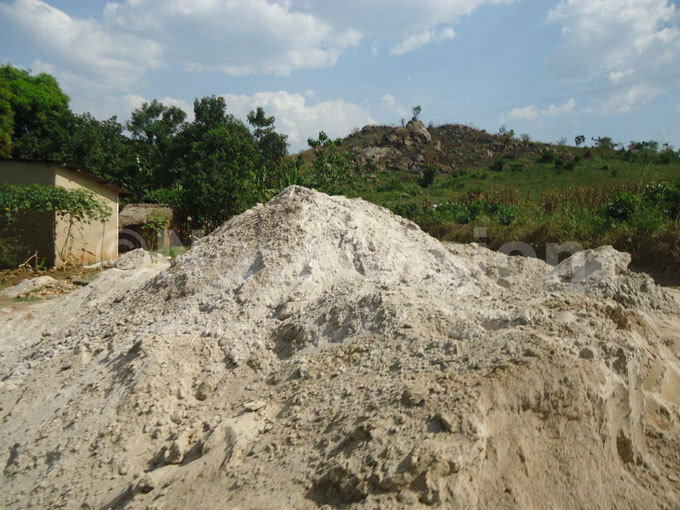Building: Do you know where the sand comes from?
"I tried dealing in charcoal, but sand mining was at least better because it does not need capital."
HOMES & CONSTRUCTION
Whoever is interested in construction will have realised that you can very easily cut your construction costs on sand by nearly a third if you can manage to go down to the quarries where it is mined and buy it yourself.
The reason for this is that the business of sand mining and commerce has grown into what nearly all other businesses grow into.
Sula Gwala, 40, and his colleagues wake up every morning to mine sand in Lwemwede village in Wakiso district. "This is where we earn a living to sustain our families".
Gwala lives in a land of surprise where nature keeps on giving him a source of livelihood. He says that this kind of job is not profitable enough to make him provide all the requirements for his family.
"I tried dealing in charcoal, but sand mining was at least better because it does not need capital. It's your energy that gets you money. The sand sells like hot cake. The only trouble is land owners don't just give away their land to miners," he says.
With so many choices of building materials and house components in the building industry today, most of us when we think of building the first consideration in choosing building materials is cost, yet we also have to know where we get these building materials, like sand.
Where sand comes from
When you are along the Mukono-Katosi road, tipper-trucks are more than any other cars, to and from Katosi where sand mining takes place.
Sand traders in Gayaza, Ntinda, Kyabando, Matugga Kasangati confirm that most of the sand people use around Kampala comes from Katosi.
Other areas like Lwemwede in Wakiso, Buleemezi in Luwero, Lukaya near Masaka, Bugerere in Kayunga, Malaba are among the others but Uganda has many different areas of sand mining.
Robert Kamya has been in this business for the last three years and says that most of the sand quarries seem to belong to no-one, but it is only in the case of quarries found in privately owned land where miners pay sh5,000-10,000 per truck to the landlord.
How sand gets to trucks
According to Kamya, when vehicles reach quarries, the miners are the ones who dig the sand, sieve it and pile it up into knolls.
"For magulu kumi (truck) with floor sand to above its brim level and create a sort of hill on top, you pay sh70,000-90,000. For porters, a truck owner has to pay sh20,000-25,000 who fill the truck with sand. Forward truck is filled for sh40,000-50,000 with sh5,000-10,000 paying porters. The Isuzu Elf will cost sh15,000-20,000 to fill up, with sh5,000-10,000 going to porters", he explains.

Away from quarry
Isam Matovu, a truck driver who parks in Kyebando, says getting sand from the quarry to the dumping site is more complicated because many traffice police officers ask for bribes.
"You can't guess how much they can ask for today. You might give them sh20,000, another day, you can even pay sh50,000 or sh100,000 when these cops accuse you of speeding, having bad tyres, over loading. But this depends on the traffic officer's wallet", he says.
Specific areas for selling or buying
There are various yards filled with large collections of sand. And this sand will just wait for buyers.
Many truck drivers get this sand from different quarries and dump it in different places around Kampala. Such dumping markets are Ntinda, Kiwatule, Kyabando, Mtaugga, Kyetume, Kireka among others.
Buying from dumping sites
Bernard Kawalya, a sand dealer in Matugga, says a ten-tyre tipper truck (magulu kumi) ranges between sh400,000-600,000 around the city areas, but is dependent on the distance and the quality, while that of the plaster ranges between sh400,000-500,000.
He says the shortage of mining areas has forced their prices up Drivers and dealers have started getting them from islands and from far areas. However, unscrupulous dealers are taking advantage of the increased demand for the sand.
Why some sand is good and other bad
Fred Lukoda, who is in the construction industry, says that most of the city sand mines are overdrawn, and this is depleting distant areas like Lake Victoria islands, while others are currently getting this sand as far as Masaka and Bugerere.
"But there are many developers who are opting for cheap building materials, especially the sand. Not any sand is good, the bad one brings cracks in structures," he says.
According to Lukoda, some people harvest the building sand from trenches and valleys brought by running water from a downpour. Some people deal in ordinary brown soils, which are disguised as the lake sand. And that's why a developer needs an expert when he or she is buying building materials.
Although sand mining is helping the construction industry to grow, the business also contributes to the death of the fish industry near lakes.
How you can know bad sand
Architect Abdu-Wahab Nyanzi says sand with impurities is bad. The commonest impurity is clay in it.
"The difference in composition of clay causes cement mixes to crack and lowers performance in strength. Sometimes the sand may be good when it's delivered on site but it is contaminated by builders at times", he adds.
Contaminated sand comes from mixing on dirty backgrounds and using dirty water. Mixes should be made on clean backgrounds like flat steel, timber board or plastered platform to avoid contamination.